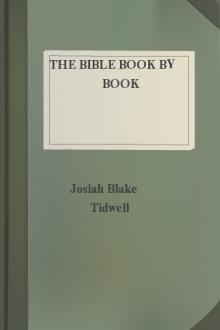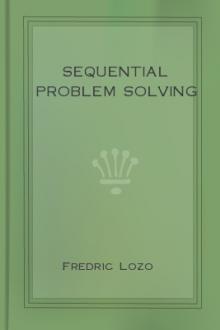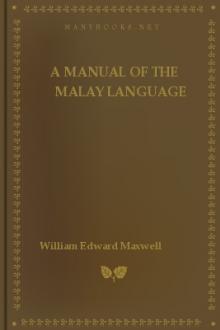The Bible Book by Book by Josiah Blake Tidwell (best short books to read .txt) 📕

- Author: Josiah Blake Tidwell
- Performer: -
Book online «The Bible Book by Book by Josiah Blake Tidwell (best short books to read .txt) 📕». Author Josiah Blake Tidwell
Purpose and Contents. The purpose was to prevent apostacy from Christianity to Judaism and incidentally to comfort them in their suffering and persecution. To accomplish this purpose the author shows, by a series of comparisons, that the religion of Christ is superior to that which preceded it. "Better" is the key-word, which along with other terms of comparison such as "more excellent" is constantly used to show the superiority of Christianity. It is very much like a sermon, the author often turning aside to exhort, then returning to the theme.
Date. It was written from Jerusalem, Alexandria or Rome some time before A. D. 70, since the temple was still standing, 9:6-7; 10:1.
Analysis.
I. Christianity is Superior to Judaism because Christ through Whom it was Introduced is Superior to the Messengers of Judaism, chs. 1-6.
1. He is superior to prophets, 1:1-3.
2. He is superior to angels. 1:4-2 end.
3. He is superior to Moses, including Joshua, chs. 3-6.
Three points in each of these comparisons are the same.
1. He is God's son.
2. He is man's Savior.
3. He is man's high priest.
Neither prophets nor angels nor Moses equal Jesus in these points. There are two notable exhortations, (a) 2:1-4; (b) 5:11-6 end.
II. Christianity in Superior to Judaism because Its Priesthood is Superior to that of Judaism, 7:1-10:18.
1. Christ its priest is superior to the priests of Judaism, 7:1- 8:6.
2. Its covenant is superior to that of Judaism, 8:7 end.
3. Its tabernacle is superior to that of Judaism, ch. 9.
4. Its sacrifice is superior to those of Judaism, 10:1-18.
III. Christianity is Superior to Judaism, because the Blessings it Confers are Superior to those of Judaism. 10:19-11 end.
1. In the liberty of approach to God, 10:19 end.
2. In the superior ground of faith, 11:1-12:17.
3. In our coming to Mount Zion instead of Mount Sinai, 12:18 end.
IV. Practical Conclusion, ch. 13.
For Study and Discussion. (1) Description of Christ. 1:1-3. (2) Christ's superiority to angels. 1:3-14. (3) Christ's humiliation for our salvation, 2:9-18. (4) How is Christ superior to Aaronic priests, 3:14, 15; 5:1-7, 9; 7:28. (5) The two covenants, 8:6-12. (6) Typical character of the old ordinances. 9:1-10:4. (7) Our assurance and hope, 6:13-20. (8) The danger of rejecting Christ, 10:26-31. (9) The benefit of affliction, 12:4-11. (10) The comparisons of 12:18-29. (11) The warning of 13.-8-15, (12) The exhortations of the book, as 2:1-4. Make a list. (13) All the terms of comparison, as better and more excellent. Make a list. (14) Every reference to Christ as high priest. (15) Every reference to the Holy Spirit-What are his works and where in the book is it taught?
James.
The Author. Three persons called James are mentioned in the New Testament. One of these is James, the Lord's brother (Matt. 13:55), who did not believe on Jesus until after the resurrection, Jno. 7:2-9; Mar. 3:21, 31; Acts 1:13-14. This James occupies and important place as pastor at Jerusalem, and made an important speech at the council of the Apostles, Acts 15: 13-21. He is mentioned elsewhere, in Acts, 12:17; Gal. 1:19; 2:9-12. Josephus tells us that he was stoned to death about 62 A. D. on a charge of departing from the Jewish law. This James, the Lord's brother, is supposed to be the author of this epistle.
To Whom Written. This letter was written to the Jews scattered everywhere, 1:1, and evidently to Christian Jews, 2:1. Some of them were rich, some poor, 2:1-10. They were lustful, greedy, and proud, 4:1-12, and were omitting to do the Lord's work as they should. 1:22- 27.
The Epistle. The chief characteristic of style is abruptness. Change is made from one subject to another with no effort to connect them. There is, therefore, no general subject, and a lack of close connection between the points of analysis. "Faith without works is dead" flashes in every section as a sort of bond of unity. It is eloquent, stern and sincere, and has a distinct Jewish tone. It lacks the doctrinal emphasis found in Paul and states the Christian faith in terms of moral excellence and instructs them in the subject of Christian morals. It is notable for its omissions. It does not have the resurrection or ascension and only mentions Christ's name twice. Date and Place of Writing. It was no doubt written from Jerusalem where he was pastor, but the date is much disputed. Some put it as early as A. D. 40. Others among whom is Dr. Robertson say it was written not later than A. D. 50. Still others put it about A. D. 61 or 62, just before the martyrdom of James. It is probably safe to say that it was one of the very earliest of the New Testament books.
Analysis.
Salutation, 1:1.
I. Proper Attitude Toward Trials. 1:2-18.
II. Proper Altitude Toward God's Word, 1:19-27 end.
III. Various Warnings. 2:1-4:12.
1. Against respect of persons, 2:1-13.
2. Against barren professions of faith, 2:14-26.
3. Against the dangers of the tongue, 3:1-12.
4. Against false wisdom, 3:13-18.
5. Against quarrels, greed and pride. 4:1-12.
IV. Various Denunciations, 4:13-5:6.
V. Various Exhortations, 5:7-20 end.
For Study and Discussion. (1) From the following scriptures make a list of all the things James advises us not to do: 1;6, 13, 16, 22; 2:1, 14; 3:1. 10; 4:1, 11, 13; 5:9, 12. (2) From the following scriptures make a list of all the things James advises us to do; 1:2, 4, 5, 6, 9, 11, 22, 26; 2:8, 12; 3:13; 4:8. 5:7, 10, 12, 13, 16, 19. (3) Make a sketch of heavenly wisdom, showing the different things said about it, studying especially, 1:5-8 and 3:13-18. (4) Study the ethics of speech and of the tongue, 1:19-21 and 3:1-12. (5) Life's trial and temptations, 1:2-4, 12-15. (6) Make a list of ail the figures of speech, especially similes and metaphors as "a doubter is like a surge of the sea," 1:6. (7) James' rebuke of selfishness, 5:1- 6. (8) The utility and power of prayer, 5:13-18.
First and Second Peter.
The Author. The author was the Apostle Peter, whose name before he became a disciple, was Simon. He was born in Bethsaida and lived in Capernaum where he followed the occupation of fishing. He was brought to Jesus by Andrew, his brother, and became one of the leaders of the Apostles, both before and after Christ's death. His career should be studied as it is found in Acts. He was impetuous, brave and energetic, and after the ascension performed many miracles.
First Peter.
Those Addressed. The sojourn of the dispersion (1:1) points to Jewish Christians. They were strangers (sojourners) 1:1, 17; 2:11, who were persecuted, 3:17; 4:12-19, but whose persecution came, not from the Jews, but from pagans, 4:3-4. They had certain faults and wrong tendencies, 2:1, 11, 12, 16; 8:8-12; 4:9; 5:2-3.
Purpose. To console them in their suffering, and to exhort them to faithfulness and duty.
Date. Probably about 64-68 A. D. Certainly not after 70 A. D., as he was not doubt put to death before then.
Analysis.
Introduction, 1:1-2.
I. Thanksgiving for the Blessing of Grace, 1:3-12.
1. For a living hope and an abiding inheritance, 3-5.
2. For joyful faith during trials, 6-9.
3. For salvation, 10-12.
II. Obligations Growing out of the Blessings of Grace, 1:13-4:19.
1. A right relation of the heart toward God and man, 1:13-2:10.
2. Right conduct in life relations, 2:11-3:12.
3. Right attitude toward suffering, 3:13-4:19 end.
III. Exhortations to Particular Classes, 5:1-9.
Conclusion 5:10 end.
For Study and Discussion. (1) Peter's loyalty to Christ. (a) He makes everything depend on Christ, his cross (1:18-19; 2:24; 3:18), his suffering (2:21; 3:18; 4:13), his resurrection (1:3), his manifestation (1:7-13), his exaltation (3:22; 4:11; 5:10). (b) He calls Christ a living stone, 2:4-8. (c) He clings to Christ's teaching, submission to rightful authority (2:13-16), forgiveness of others (4:8; Matt. 18:22), humility (5:5). (2) The mercy of God our hope 1:3-7. From this passage list what is said of spiritual inheritors and their inheritance. (3) How to obtain the Christian ideal, 1:13-21. (4) Spiritual development. 2:1-10. (5) Various deities of society, 2:13-17; of domestic life 2:18; 3:1, 7; of Christian brotherhood, 1:22, 2:1-5; 3:8-9; 4:8-11; 5:1-5. (6) The work of the different persons of the Trinity. (7) The words precious, joy and rejoicing, mercy, love and faith.
Second Peter.
The Occasion. The occasion of the epistle is found in the harm being done to the church by false teachers, who were of two classes, the libertines and the mockers about whom he warns.
Purpose. Its purpose was to exhort them to Christian growth and to warn them against false teachers.
Comparison with First Peter. It has no reference to Christ's death, suffering, resurrection and ascension. Glance through 1 Peter again to see how often these are mentioned. The spirit manifested is one of anxiety, severity, and denunciation, white in 1 Peter it is one of mildness, sweetness and fatherly dignity. It connects the second coming of Christ with the punishment of the wicked, while 1 Peter connects it with the glorification of the saints. Its key-note is knowledge, while that of 1 Peter is hope.
Some Teachings. (1) To be holy, not to secure an inheritance, but because we already have it. (2) To love the brethren, not to purify our soul, but because it is pure. (3) That we sacrifice, not as penance, but as an expression of praise.
Analysis.
Introduction, 1:1-2.
I. Progress in the Christian Life, 1:3-21 end.
1. An exhortation to growth, 3-11.
2. Reasons for these exhortations, 12-21.
II. False Teachers, Ch. 2.
1. The evil teachers and their followers, 1-3.
2. Their punishment, 5-10.
3. Their character, evil ways and end, 11-32.
III. The Second Coming of Christ, 3:1-13. He will bring both blessings and destruction.
Conclusion, 3:14-18.
For Study and Discussion. (1) What our salvation involves, 1:5-11. (2) The characteristics of the false teachers, 2:1-3, 10, 12-14. (3) The certain punishment of these false teachers, 2:4-6, 15, 16, 21, 22. (4) The exhortations of the book such as to sobriety, 1:13. (5) The predictions of the book.
First, Second and Third John and Jude.
First John.
Author and Date. It was probably written from Ephesus, 80 or 85 A. D. though some put it as early as A. D. 69, while others put it as late as A. D. 95. The author nowhere indicates his name, but through all the centuries it has been attributed to John, the beloved disciple. For information concerning him see lesson twenty-eight.
The Readers. It was doubtless written primarily to the churches of Asia Minor in which John by reason of his work at Ephesus had a special interest. It is evident that those addressed were of all ages and were hated of the world. They were inclined to worldliness and to the danger of looking too lightly upon sin. They were also in danger of being led into doubt by those who denied the deity of Jesus.
The Style. It is more in the form of a sermon or pastoral address than of an epistle. It is written with a tone of conscious authority. The thought is profound and mystical, but the language is simple both in words and in sentences. The arguments are by immediate inference. Their are many contrasts, parallelisms and repetitions with no figures of speech except perhaps the words light and darkness.
The Purpose. The chief purpose was to tell them how they might know that they had eternal life, 5:13. The accomplishment of this purpose would also assure the fulfillment of the secondary purpose stated in 1:3, 4.
Theme. The evidence of eternal life.
Analysis.
Introduction, 1:1-4.
I. How Those Who Possess Eternal Life will Live, 1:5-5:12.
1. They will dwell in the light, 1:5-2:28.
2. They will do righteousness, 2:29-4:6.
3. They will live a life of love, 4:7-5:3.
4. They





Comments (0)